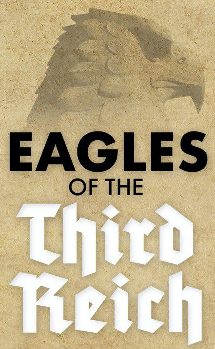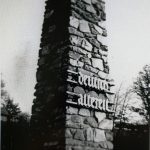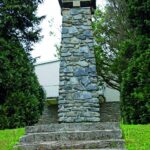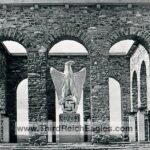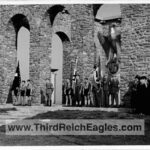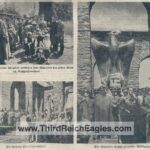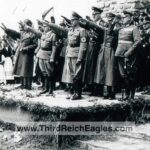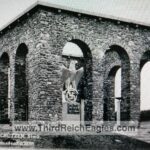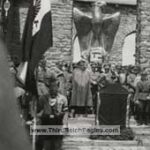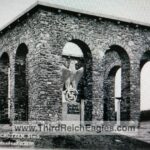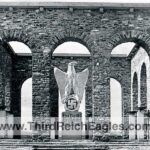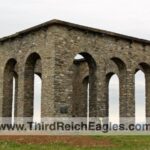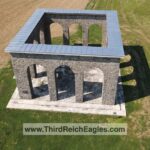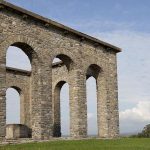Various names were used in the Nazi era included (“Grenzlandmal”, “Ehrenmal”, “Mahnmal”, “Anschlussdenkmal”, “Weihestätte”, “Anschlussweihestätte”, etc.) The term “Anschlussdenkmal” prevailed, under which the monument is known to this day.
Availability: Unique – only one created (since destroyed)
Location today: The monument remains in Burgenland municipality of Oberschützen. The gilded eagle however was rumoured to have been destroyed by the Russians (either by being shot to rubble or by an anti-tank gun). There is an additional rumour that it remains preserved in the cellar of one of the original erectors of the monument.
Creators: Graz architect Rudolf Hofer with the collaboration of the sculptor Hans Adametz and the sculptor Wilhelm Gösser
Eagle: Gold gilded stone over 2m in height on a stone pedestal
History:
In 1931, a so-called “small union monument” in the form of a memorial stone was erected in Oberschützen. Theis was to recognise the tenth anniversary of Burgenland belonging to Austria. It stands outside the village at a slightly elevated point on the road to Jormannsdorf . This smaller monument was designed by Rudolf Hofer in the form of an obelisk with a fire bowl in June 1931. This monument now sits in front of the secondary school in Oberschützen. Two inscriptions, which have since been removed, were attached to the towering monument in the style of an “old Germanic sacrificial stone”. On the front of the monument, the battle slogan “Deutsch allezeit” Germany always; On the back: ” Ragender Stein! Mahne noch später Geschlechter, immerdar schirmende Wächter Deutschlands zu sein! ” Rising stone! Even later, warn generations to always be protective guardians of Germany! During the National Socialist era, the monument served as a place for political rallies until the new larger memorial was erected.
The new memorial replaced a smaller memorial. After Austria’s “annexation” to the National Socialist German Reich, a memorial was builtin 1938/1939 in Oberschützen, Burgenland. The groundbreaking took place on 7. October 1938 by the district leader Eduard Nicka (1911-1972), who comes from Unterschützen, in the presence of the Gauleiter Deputy Dr. Tobias Portschy, who took over the patronage of the project. It was inaugurated on May 21, 1939 in the presence of several high ranking national socialist members (including Gauleiter of Styria Siegfried Uiberreither (1908-1984) and his Deputy Dr. Tobias Portschy (1905-1996)) and district leader Eduard Nicka.
Pics:
The larger memorial design was based on the model of the Tannenberg Monument (1924-1927) in East Prussia. The building material came from quarries in the Sulzriegel district of the Bad Tatzmannsdorf community. In the months after the laying of the foundation stone on October 7, 1938, the “Grenzlandmal” was completed with support from the entire population.The monument is a square, spacious pillared courtyard eight meters high and twelve meters wide and is considered the largest National Socialist monument in Austria. In the center of the monument was a large (> 2m) gold gilded stone eagle with the swastika framed in oak leaves in its claws, positioned on a pedestal with the inscription “Ein Volk, Ein Reich, Ein Fuhrer” (One People – One Reich – One Leader) on the base. The eagle was facing southeast towards Hungary, with its wings half open. There were 8 Pylons with copper braziers flanking the pillars.
Post war pics:
After the war the inscription & fire bowls were removed and the gilded eagle destroyed. There have been repeated discussions about tearing down the monument, but this has never happened. Planning was difficult because the property consisted of several parcels with different owners. In the years that followed, the building has been used in different ways (campfires, midsummer fires, nude photo shoots, etc.), but for a long time remained taboo with regard to the history of its origins and how it was dealt with.
It has remained controversial. In 2016 the municipality of Oberschützen succeeded in leasing the parcels on which the monument is located for 30 years. The building was also placed under monument protection and renovated in 2018/19 in cooperation with the Federal Monuments Office.
Plaque:
 In 1997, after a long struggle, the memorial was re-invented as a memorial against violence and racism. A small plaque was attached to the memorial. The wording:
In 1997, after a long struggle, the memorial was re-invented as a memorial against violence and racism. A small plaque was attached to the memorial. The wording:
Erected in 1939 as a memorial for the annexation of Austria to National Socialist Germany.
May this place for us now and in the future
To be a memorial:
against dictatorship, against violence, against
Racism – for democracy, for peace
and for the protection of human rights!
Oberschützen community, 1997
